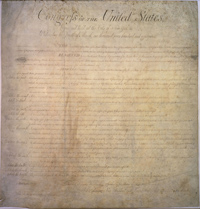 Note: The Following is an edited version of a short history of the Constitution on the National Archives and Records Administration’s website: Note: The Following is an edited version of a short history of the Constitution on the National Archives and Records Administration’s website:
On “May 25, 1787, …Robert Morris of Pennsylvania, the ‘financier’ of the Revolution, opened the proceedings with a nomination — Gen. George Washington for the presidency of the Constitutional Convention… Seventy-four delegates were appointed to the convention, of which 55 actually attended sessions… Most of the delegates had studied law, had served in colonial or state legislatures, or had been in the Congress… On Tuesday morning, May 29, Edmund Randolph, the tall, 34-year- old governor of Virginia, opened the debate with a long speech decrying the evils that had befallen the country under the Articles of Confederation and stressing the need for creating a strong national government… The proposed government had three branches — legislative, executive, and judicial — each branch structured to check the other. Highly centralized, the government would have veto power over laws enacted by state legislatures. The plan, Randolph confessed, ‘meant a strong consolidated union in which the idea of states should be nearly annihilated’… On June 13 delegates from smaller states rallied around proposals offered by New Jersey delegate William Paterson. Railing against efforts to throw the states into ‘hotchpot,’ Paterson proposed a ‘union of the States merely federal.’ The ‘New Jersey resolutions’ called only for a revision of the articles to enable the Congress more easily to raise revenues and regulate commerce. It also provided that acts of Congress and ratified treaties be ‘the supreme law of the States’… On Monday Aug. 6, 1787, the convention accepted the first draft of the Constitution… The most serious controversy erupted over the question of regulation of commerce… On Aug. 21 the debate over the issue of commerce became very closely linked to another explosive issue — slavery. When Martin of Maryland proposed a tax on slave importation, the convention was thrust into a strident discussion of the institution of slavery and its moral and economic relationship to the new government… One of the last major unresolved problems was the method of electing the executive. A number of proposals, including direct election by the people, by state legislatures, by state governors, and by the national legislature, were considered. The result was the electoral college, a master stroke of compromise, quaint and curious but politically expedient. On Sep. 17 the members met for the last time… As the members of the convention returned home in the following days, Alexander Hamilton privately assessed the chances of the Constitution for ratification. In its favor were the support of Washington, commercial interests, men of property, creditors, and the belief among many Americans that the Articles of Confederation were inadequate. Against it were the opposition of a few influential men in the convention and state politicians fearful of losing power, the general revulsion against taxation, the suspicion that a centralized government would be insensitive to local interests, and the fear among debtors that a new government would ‘restrain the means of cheating Creditors.’ By Jan. 9, 1788, five states of the nine necessary for ratification had approved the Constitution — Delaware, Pennsylvania, New Jersey, Georgia, and Connecticut. But the eventual outcome remained uncertain in pivotal states such as Massachusetts, New York, and Virginia. On Feb. 6, with Federalists (Pro Constitution) agreeing to recommend a list of amendments amounting to a bill of rights, Massachusetts ratified by a vote of 187 to 168… Rhode Island on Mar. 24 turned down the Constitution in a popular referendum by an overwhelming vote of 10 to 1… [In Maryland] the final vote on Apr. 28, [was] 63 for, 11 against… On July 2, 1788, the Confederation Congress, meeting in New York, received word that a reconvened New Hampshire ratifying convention had approved the Constitution. With South Carolina’s acceptance of the Constitution in May, New Hampshire thus became the ninth state to ratify. The Congress appointed a committee ‘for putting the said Constitution into operation.’ In the next 2 months, thanks largely to the efforts of Madison and Hamilton in their own states, Virginia and New York both ratified while adding their own amendments. The margin for the Federalists in both states, however, was extremely close. Hamilton figured that the majority of the people in New York actually opposed the Constitution, and it is probable that a majority of people in the entire country opposed it. Only the promise of amendments had ensured a Federalist victory. Source: National Archives and Records Administration |